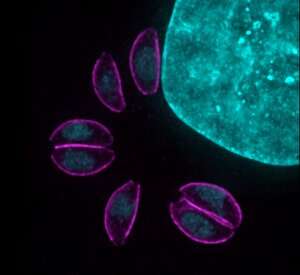Researcher working to uncover key to cellular mechanisms in parasite

Toxoplasmosis is a common but usually non-life-threatening parasitic infection linked to contaminated food or water. While most people infected by Toxoplasma gondii (T. gondii), the parasite responsible for toxoplasmosis, will have very mild or no symptoms at all, the parasite can persist in the body for long periods of time, possibly even an entire lifetime.
People who are immunocompromised and babies, if infection occurs in utero, can suffer severe symptoms. If a person's immune system cannot combat the infection, it may cause damage to the brain, eyes, or other organs. T. gondii is a leading cause of congenital neurological defects.
University of Connecticut assistant professor of molecular and cell biology Aoife Heaslip has received a $2 million grant from the National Institute of General Medical Sciences to study molecular functions of T. gondii. Heaslip hopes this work will provide a better understanding of how this parasite operates and thus pave the way for new therapeutic approaches.
Heaslip will focus on T. gondii's intracellular cargo transport mechanism. This process involves the movement of vesicles—cellular transport containers for materials like proteins—within a cell. Intracellular transport and vesicle secretion are essential cellular functions for all eukaryotes. For T. gondii, they are key to this pathogens ability to invade and grow within its host's cells.
Despite its importance, to date, scientists have only studied cargo transport mechanisms in a small number of model species leaving wide knowledge gaps about how other eukaryotes, like T. gondii, complete this task.
The goal of Heaslip's lab is to uncover the cargo transport mechanism in T. gondii. Their previously published data show there are two proteins: actin and unconventional myosin (MyoF), required for intracellular cargo transport in T. gondii. Both proteins are part of the T. gondii's cytoskeleton, the part of the cell responsible for maintaining cell shape and locomotion.
This new project will expand on Heaslip's previous work to uncover the details underlying this mechanism.
Heaslip's lab will utilize an interdisciplinary combination of approaches including parasite genetics and cell biology, live cell imaging and quantitative vesicle tracking, and in-vitro biophysical approaches to answer these questions.
"My laboratory occupies a unique niche at the intersection between parasitology and molecular motors fields," Heaslip says. "Utilizing these interdisciplinary approaches makes us ideally positioned to provide new insights into this understudied process."
Heaslip will work to understand how the cells regulate MyoF activity and how cargo packaged in vesicles interact with the actin cytoskeleton. She will also identify if there are additional molecular plays required for cargo transport and how they work with actin and MyoF to accomplish this task.
This work is relevant beyond toxoplasmosis as T. gondii is closely related to parasites that cause malaria and life-threatening diarrheal diseases. Understanding T. gondii's transport mechanism will also provide insights into these parasites.
By understanding how a parasite like T. gondii completes cargo transport functions, scientists can leverage that knowledge to develop ways to interrupt this process with drugs that would kill the parasite.
Provided by University of Connecticut





















